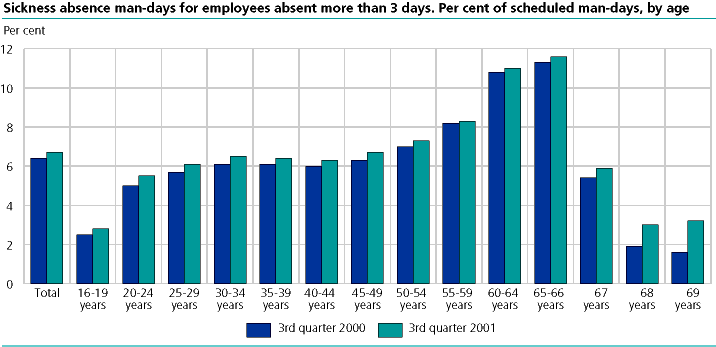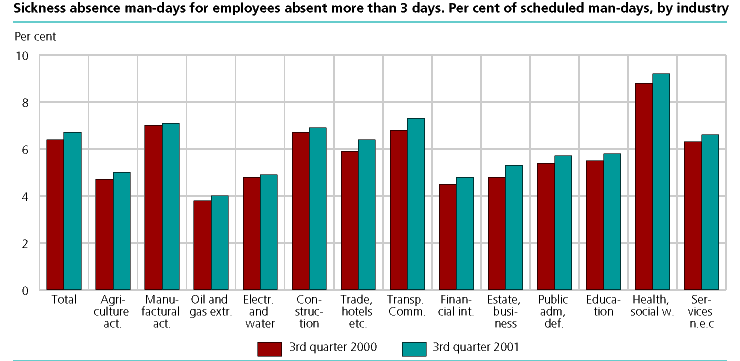Content
Published:
This is an archived release.
Sickness absence increased 4.7 per cent
The sickness absence rate increased from 6.4 per cent to 6.7 per cent from the third quarter of 2000 to the third quarter of 2001. This equals a growth of 4.7 per cent. The sickness absence increased the most for young employees and women.
Increases most among young and least among elderly
The sickness absence rate increased for all age groups last year. The growth was strongest in the age group 20-24 where the sickness absence rate increased from 5.0 to 5.5 per cent. The absence increased least among the oldest age groups. In the age group 60-64 the sickness absence increased from 10.8 to 11.0 per cent.
Higher growth among women
The sickness absence rate increased 0.5 percentage points among women and 0.3 percentage points among men from the third quarter 2000 to the third quarter 2001.
The highest growth among women was in construction, 1.5 percentage points, transport and communication, 0.9, and business activities, 0.8. Men had the largest growth in the sickness absence rate in education, 0.7 percentage points, health and social work, 0.6 percentage points and wholesale and retail trade, hotels and restaurants, 0.5 percentage points.
Largest increase in business activities, small increase in manufacturing
The sickness absence rate increased the most in business activity, retail trade, hotels and restaurants and transport and communication. These industries had a 0.5 percentage points increase. Business activities had a relatively low level of sickness absence last year.
The manufacturing industry and electricity and water supply had a small increase, 0.1 percentage points.
Highest rate in Finmark, lowest in Rogaland
The three northern counties are the only counties with a sickness absence rate higher than 8, with Finmark having the highest rate, 8.7 per cent, an increase of 1.1 percentage points from last year. Rogaland had the lowest sickness absence rate, 4.9. The growth in Rogaland was modest last year, only a 0.1 percentage point increase.
Statistics Norway has not taken into consideration possible differences among the counties when it comes to age and industry.
Seasonal growth from 2nd to 3rd quarter
The sickness absence rate increased 0.5 percentage points, from 6.2 to 6.7 per cent, from the 2nd to the 3rd quarter of 2001. This growth is partially due to normal seasonal differences. In 2000 the growth between the same quarters was 0.2 percentage points. We do not have long enough time series to tell what a normal seasonal change looks like.
Tables:
- Table 1 Sickness absence man-days for employees with more than 3 days of sickness absence certified by a doctor, by sex and age. Figures and per cent of scheduled man days (sickness absence rate). Quarterly figures
- Table 2 Sickness absence man-days for employees with more than 3 days of absence certified by a doctor, by sex and industry. Figures and per cent of scheduled man-days (sickness absence rate). Quarterly figures
- Table 3 Sickness absence man-days for employees with more than 3 days sickness absence certified by a doctor, by industry. Figures and per cent of scheduled man days (sickness absence rate). Quarterly figures
Tables
The statistics is published with Sickness absence.


